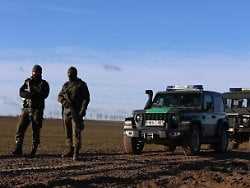Border fence to Belarus
A visit to Poland’s migrant fortress
01/23/2022, 7:59 p.m
When the Belarusian dictator Lukashenko wanted to bring thousands of migrants across the Polish border into the EU in the fall, Warsaw responded by building a border facility. Since then, soldiers have been guarding the country’s eastern border – as few as possible should know what’s going on in the exclusion zone.
Behind the village of Usnarz Gorny in eastern Poland, the dirt road leads down a slope. The border guard takes his foot off the accelerator. Then the jeep rumbles through deep ruts made by military trucks in the once-soaked and now rock-hard frozen ground. Below, soldiers stand guard in the freezing wind. What everyone here just calls a “concertina” glitters in the winter sun: a makeshift barbed-wire barrier erected by Poland on the EU’s external border with Belarus. It is intended to deter migrants who want to go west from Poland’s neighboring country.
“In the coming week we will start building a permanent barrier,” says Major Katarzyna Zdanowicz, spokeswoman for the Polish border guard. According to the plans of the government in Warsaw, a 5.5 meter high fence is to be built at the border – Poland wants to spend the equivalent of 366 million euros on the structure. For months, thousands of migrants have been trying to get from Belarus to Poland and the Baltic States via the EU’s external borders. The EU accuses Belarusian ruler Alexander Lukashenko of deliberately flying in people from crisis areas in order to smuggle them into the EU.
Poland has completely sealed off and militarized the border area. Around 15,000 soldiers are deployed here, along with thousands of border guards and police officers. A three-kilometre-wide strip along the border has been a restricted zone since September, access for non-residents is forbidden. Only recently has the border guard allowed journalists a controlled look – with organized tours. Distrust is high, as is nervousness: “One step back, immediately!” a soldier yells at a cameraman when he fails to keep a distance of 15 meters from the border fence.
The uniformed wear balaclavas, none of the masked men are allowed to name or express themselves. The village of Usnarz Gorny is also in the exclusion zone. Tattered tents can be seen just behind the barbed wire on the Belarusian side. Remains of an abandoned camp of migrants who were stuck here for weeks in the autumn. “We know that the Belarusian security forces organized their stay and detained them here. And just as they were brought here, they were taken away again on a certain night,” says Katarzyna Zdanowicz.
Constantly new methods
A military jeep with loudspeakers on the roof is parked in a field within sight of the border. “The Polish border is closed. This is the end of your journey. Go back to Minsk,” it booms in English, French and other languages. In the forest on the Belarusian side there is no one who could hear it. In the meantime, there are no longer several hundred, but several dozen people every night who try to cross the border illegally, says Zdanowicz. But the pressure continues. “Lately, people have also been taken to terrain that is very difficult to access and pushed across the border there.”
The Belarusian side is constantly coming up with new methods. Polish aid organizations also confirm: the crisis is not over yet. “In the first three weeks of January, 345 people in the border area asked us for humanitarian, medical or legal help,” says Monika Matus from the “Border Group” action alliance. However, it is difficult for the helpers to assess exactly what is happening in the restricted area: Despite many international appeals – including from Federal Foreign Minister Annalena Baerbock – Poland does not allow any aid organizations into the restricted area. And the border guards make no secret of the fact that they are deporting most of the migrants back to Belarus.
In the village of Minkowce, wells stand next to colorful wooden houses, and the only street leads directly to the border fence. The villagers are mostly elderly people. Few want to talk to journalists in front of border guards and soldiers. “It’s great that the soldiers are here. You have to do everything you can to protect what we have,” says 66-year-old pensioner Jozef. After all, the soldiers and border guards would not only protect Poland from the migrants and Lukashenko’s provocations, but the entire EU and NATO countries.
Not everyone in the 183 towns in the exclusion zone is so enthusiastic. “I don’t feel like I’m at home anymore, I feel like I’m at a military training ground,” complains a resident of the village of Nowe Masiewo near Bielowieza National Park. Day and night, military trucks rolled through the village, helicopters and drones rattled over the roofs, the children were afraid of meeting soldiers in the forest, the 27-year-old says on the phone. She doesn’t want her name printed. “I’m afraid of the reaction of the neighbors.”
